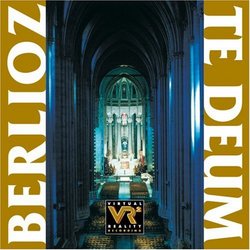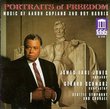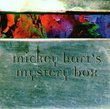| All Artists: Hector Berlioz-Voices of Ascension Title: Berlioz: Te Deum Members Wishing: 0 Total Copies: 1 Label: Delos Records Original Release Date: 3/20/1997 Release Date: 3/20/1997 Genres: Special Interest, Classical Style: Opera & Classical Vocal Number of Discs: 1 SwapaCD Credits: 1 UPC: 013491320021 |
Search - Hector Berlioz-Voices of Ascension :: Berlioz: Te Deum
 | Hector Berlioz-Voices of Ascension Berlioz: Te Deum Genres: Special Interest, Classical
Berlioz's Te Deum is one of his largest works--not quite the extravaganza that he made of the Requiem, with its 4 brass bands and 16 timpanists, but big enough! It requires three choruses, an augmented orchestra, and... more » ![header=[] body=[This CD is available to be requested as disc only.]](/images/attributes/disc.png?v=a4e11020) ![header=[] body=[This CD is available to be requested with the disc and back insert.]](/images/attributes/disc_back.png?v=a4e11020) ![header=[] body=[This CD is available to be requested with the disc and front insert.]](/images/attributes/disc_front.png?v=a4e11020) ![header=[] body=[This CD is available to be requested with the disc, front and back inserts.]](/images/attributes/disc_front_back.png?v=a4e11020) |
Larger Image |
CD DetailsSynopsis
Amazon.com Berlioz's Te Deum is one of his largest works--not quite the extravaganza that he made of the Requiem, with its 4 brass bands and 16 timpanists, but big enough! It requires three choruses, an augmented orchestra, and solo organ. The opening measures, in which the orchestra and organ alternate in throwing huge chords out into space, were made for a cathedral acoustic such is offered here. Unfortunately, that's about the best part of this performance, which takes on a distinctly amateurish cast from there on. The various choruses are simply not up to the demands of the piece (they are utterly defeated by the warlike Judex crederis, just when they should sound strongest), and the conducting, which has to simply blaze with conviction, seems more concerned with simply getting through a tough job. Yet there are no other recordings of this work readily available in the domestic catalog, and this will give you a sense of what the piece is about--but certainly no more than that. --David Hurwitz Similar CDs
Similarly Requested CDs
|
CD ReviewsA sonic spectacular! Bob Zeidler | Charlton, MA United States | 05/01/2001 (5 out of 5 stars) "Hopefully, you, the reader, will have moved past the unfairly negative editorial review by David Hurwitz and on to this one, and to the one by urcrewer below mine, someone who participated in the performance captured in this recording. The performance, and the recording as well, are far, far better than Mr. Hurwitz would have you believe. I have had the pleasure of attending many musical performances in "Big John" (an affectionate nickname for the Cathedral of St. John the Divine in New York City, and the world's largest Gothic cathedral). Even with a full crowd (which I believe is in excess of 3,000 not counting standees), its reverberation time is approximately seven seconds, which can be a challenge to not only musicians but to a recording crew as well. But the Delos crew - one of the finest in the industry - was more than up to the task of capturing not only this remarkable Berlioz work but a good deal of the natural Big John acoustic ambience in truly lifelike sound. Hector Berlioz, a "sui generis" composer if ever there were one, wrote this Te Deum as an "occasion piece" with the idea in mind that it would (and should) be performed in a cathedral, not a concert hall. For its full impact, it fairly cries out for the antiphonal sounds of the full orchestra and the pipe organ to provide a "call and response" at various points in the work (most prominently at the beginning and end, but elsewhere as well). This antiphonal intent of Berlioz simply cannot be realized in a concert hall - no matter how fine the organ - if the organ itself is not antiphonally disposed, as it can only be in a proper cathedral. The occasion for this performance, as is well spelled out in the booklet notes but totally ignored by Mr. Hurwitz, was the 100th anniversary celebration of the American Guild of Organists, which meets each year in Big John. In honor of that event, and to show off the musical and acoustical possibilities of Big John as a performance and recording venue for a work of this size, some person or persons had the foresight and the imagination to choose this Berlioz work as being perfect for the occasion. And perfect it is. Largely because of its performance requirements, Berlioz' Te Deum is infrequently performed, and even more infrequently recorded. But the Te Deum is not minor Berlioz (whatever could be called "minor" Berlioz, anyway?) but a mature, fully thought-out work. All of the forces required - choruses, orchestra, brass bands, organ, and John Aler as the tenor soloist - are fully up to the task and acquit themselves very well in a work, had it been performed under less idea circumstances, and/or recorded with less skill, would likely have turned out to be sonic mush. But this is a recording to revel in. And a pretty fair test of your sound system. A nice bonus on this disc is the illustrated discussion by Dennis Keene. It complements the performance and perfectly fills out the available time. I have only one quibble, and it is a very minor one. For this performance, Maestro Keene - of course having every right to do so - elicited the services of an organist who, while excellent, was not the Big John organist, Dorothy Papadakos. Having heard Ms. Papadakos many times, and believing her to be more than up to the task, I wonder why not? Particularly since it has been on her watch that this very fine Aeolian-Skinner organ has been restored to its earlier glory. Bob Zeidler" Remembering the Berlioz "Te Deum" urcrewer | Rochester, NY United States | 02/04/2001 (4 out of 5 stars) "The Berlioz "Te Deum" is one of the most grandiose classical compositions. It is difficult enough to amass the amount of musicians needed to perform this work, and to perform it well requires a blessing from a higher power. As a fourteen-year-old singing in the Young Singers of Pennsylvania, I vividly remember this performance. The cathedral was packed (the standing room in the aisles was filled), and even us musicians had to cram tightly together. The temperature in the cathedral was quite high, and I'll admit that I was deathly afraid of dropping my score on the first trombonist, for I was holding it directly over his left shoulder and my hands were sweaty and shaking. The aura of professionalism surrounding the concert, however, is a sentiment I will cherish. I will also never forget the satisfaction of being rendered temporarily deaf after the finale--being behind the brass section certainly has its perks!I have listened to this recording multiple times, and I am still in awe of its beauty and magnificence. I respect all the musicians, Susan and Joseph Ohrt, and especially Dennis Keene immensely for the effort they put into the event. Keene's narration found on the last few tracks adds a nice touch to the recording and is especially helpful to first-time listeners so that they may better understand the piece. In all, this version of the "Te Deum" is a very solid one. (And whenever I tell my friends nearby at the Eastman School of Music I had the opportunity to participate in the making of this recording, this political science major gains a little respect!)" Short and sweet... This is superb work.... Rachel Howard | ocklawaha, Florida United States | 03/18/2002 (5 out of 5 stars) "I don't know what recording Mr. Hurwitz was listening to, but I don't think it was this one. Hurwitz has written some excellent reviews, brimming with insight. I really do think there is a mixup here... and I know which recording it probably was. I refuse to say here, but amazon used to sell it. Read what the other reviewers say here for a far better idea of the sound and ambience of this recording: they've gotten it right! The sound, from my vantage point, is excellent, especially for a live recording. It's this recording's Tibi Omnes which gave me my first taste of the Berlioz Te Deum and it left me hungry for more. Dennis Keene seems to have a love affair with this work and with the forces he conducted. It shows in the recording and it shows in his informative, separate narration on the musical and emotional structure of this masterwork by Berlioz. Illustrated as it is by selections from the performance, it's not only educational, it's beautiful and entertaining."
|

 Track Listings (13) - Disc #1
Track Listings (13) - Disc #1













